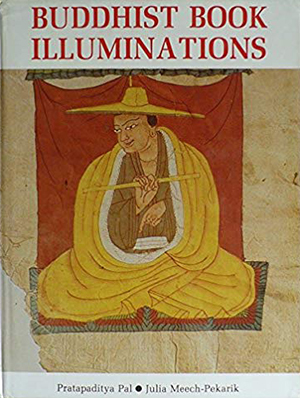Buddhist Book Illuminations
Preface
Almost three decades ago, when I was a postgraduate student at Calcutta University, I was introduced to the well-known collection of ancient Buddhist books in the Asiatic Society Library and became fascinated by the beautiful miniature pictures that many of them contained. Most of these books were from Nepal and India, and one Nepali manuscript, together with another in the Cambridge University Library, had been published extensively at the turn of the century by the noted French scholar Alfred Foucher. My interest in the subject received further encouragement in the sixties when I was attending Cambridge University, where the University Library possesses a fine collection of Indian and Nepali manuscripts. By the early 1980s I was convinced that the study of Buddhist book illuminations was fascinating and of a much wider scope than I had realized.
Almost every country in which Buddhism has flourished has produced, over the centuries, vast quantities of illustrated books, and, in fact, without books, Buddhism could hardly have spread as far as it did. Buddhists were the first to take advantage of the Chinese invention of printing to disseminate their faith, and the earliest copy of a printed book is of a Buddhist text. I was surprised, however, that—to date—no one had written a book about Buddhist illuminated manuscripts that encompassed all Buddhist cultures and could be used as a general introduction. While there is some literature on Indian, Chinese, Japanese, and Thai book illuminations, only in a recent catalogue, Buddhism: Art and Faith, published in 1985 by the British Museum, can one find material assembled from all Buddhist countries. The present study, therefore, is the first to be dedicated exclusively to Buddhist manuscript illumiminations.
This project was conceived in 1983 as a result of Ravi Kumar’s visits with me at the Los Angeles County Museum of Art, at which time we went through a vast number of manuscripts in the museum’s collection. He expressed his enthusiasm and desire to publish this badly needed book and has been most generous in making it possible. As my own knowledge of the arts of East Asia is limited, I was fortunate that my colleague and noted East Asian art historian Julia Meech-Pekarik accepted my invitation to write the chapters on China, Korea, and Japan. Her contribution enhances the value of the book, providing it with wider appeal. Readers should note, however, that the text is meant to be a general introduction to the pictures that adorn the sacred books of the Buddhists rather than to the art of writing or calligraphy.
Assembling photographs and transparencies for the book was not an easy task. Obtaining correct measurements proved to be even more difficult and, in some instances, impossible. For consistency, sutra titles have been given in Sanskrit or in their accepted English versions, such as the Lotus Sutra. A reference list of Sanskrit manuscripts mentioned in the text has also been included. Diacritical marks have been omitted for Sanskrit words used more than once in the text, but they have been provided in the Index.
Finally, it remains for us to express our sincere appreciation to the many individuals without whose generous help to both Dr. Meech-Pekarik and me this project would have remained incomplete. In particular, mention must be made of Janet Zieschang and Chitralekha Pal for preparing the manuscript. In addition, I would like to thank the following individuals: Julia F. Andrews, Stephen Markel and Ethel Heyer, Los Angeles County Museum of Art; Sondra Castile, the Metropolitan Museum of Art, New York; Helen Evans; Anne Farrer, and Jessica Rawson, British Museum, London; Roger Goepper, Museum fur Ostasiatische Kunst, Cologne; John Guy, Victoria and Albert Museum, London; Sasaki Johei, Kyoto University; Michael Knight and William Rathbun, Seattle Art Museum; Ann Main; Robert D. Mowry, the Asia Society, New York; Julia Murray, Harvard University Art Museums, Cambridge, Massachusetts; Otto E. Nelson; Kimiko and John Powers; Robert Rainwater, the New York Public Library; Valrae Reynolds, the Newark Museum; Melinda Takeuchi, Stanford University; Miya Tsugio and Yonekura Michio, Tokyo Kokuritsu Bunkazai Kenkyujo; Sandy Williams, the Mary and Jackson Burke Collection, New York; Don Wineman; and Frances Wood, British Library, London.
Pratapaditya Pal
